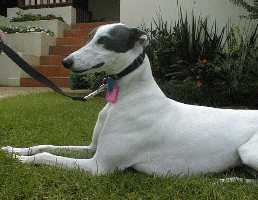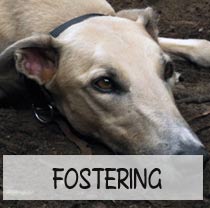 |
Welcome to the |
General information
History of the Greyhound
The antiquity of the Greyhound, like its speed, is undisputed. However, the exact location of its origins is a matter for conjecture. The Egyptian tomb of Amten, built between 2900 and 2751 B.C., shows dogs of unmistakeable Greyhound-type hunting wild deer and goats. One of the earliest written accounts of the breed comes from the Metamorphoses (Transfigurations) by the Greek poet Ovid (43 B.C. to A.D. 18). Arrian, another Greek historian and philosopher (born A.D. 96), described Canis venaticus, a dog which hunted by sight and not by scent. His description closely fits that of the Greyhound. The breed was dispersed by merchant caravan treks throughout Iraq, Iran and Russia, and was probably introduced to Britain by Celtic tribes more than 2000 years ago.
The Greyhound is the only breed of dog to be mentioned by name in the Bible (Proverbs Ch. 30, v. 29-31) where it is described as one of the four things which are 'comely in going'.
 In the English language, even the origin of the name is obscure. Early literature shows considerable variation in spelling: grehounde; greihounde; grayhounde; graihound; grewhound; grewnd. Many of these names suggest a connection with Greece. Other theories include an association with the colour grey (grey; gray; grai; grei) or suggestions that 'grey' means 'dog' and 'hundr' means 'hunter' (greyhundr). The International Encyclopedia of Dogs puts forward the theory that 'greyhound' is derived from 'gazehound', descriptive of the dog's sharp eyesight. Alternatively, Dr Caius, a 16th century writer, states: 'the greyhound with us derives his name from gre, because he holds the chief rank among dogs, gre with us denoting rank'.
In the English language, even the origin of the name is obscure. Early literature shows considerable variation in spelling: grehounde; greihounde; grayhounde; graihound; grewhound; grewnd. Many of these names suggest a connection with Greece. Other theories include an association with the colour grey (grey; gray; grai; grei) or suggestions that 'grey' means 'dog' and 'hundr' means 'hunter' (greyhundr). The International Encyclopedia of Dogs puts forward the theory that 'greyhound' is derived from 'gazehound', descriptive of the dog's sharp eyesight. Alternatively, Dr Caius, a 16th century writer, states: 'the greyhound with us derives his name from gre, because he holds the chief rank among dogs, gre with us denoting rank'.
The ability of the Greyhound to hunt deer, fox or hare for sport directed his future with the wealthy classes. In centuries past, the destruction of a Greyhound was looked upon as an act 'equally criminal with the murder of a fellow man'. In 1016, King Canute passed a law that 'no meane person may keepe any greihounds'. It became exclusively a dog of royalty and nobility, and very much a status symbol.
In the mid 1700's Lord Orford, an eminent patron of coursing, is credited with much of the improvement in the form and quality of the Greyhound that we know today. He crossed his dogs with English Lurchers for attention and teachableness and with the Italian Greyhound to increase delicacy of the skin, lightness of frame and speed of motion. Lastly, by crossing with the bulldog, he was able to introduce a small ear, finely tapered tail, sleek coat and tremendous courage. It was only following this last cross-breeding effort that the brindle colour, so common in modern Greyhounds, first appeared.
Throughout the discovery and the establishment of convict settlement in Australia, the Greyhound again featured prominently. Two of the breed accompanied Sir Joseph Banks on his voyage in the Endeavour. A letter from Elizabeth Macarthur, written in 1794, attests that 'with the assistance of one man and half-a-dozen greyhounds...my table is constantly supplied with wild ducks or kangaroos'. With the further passing of time, perhaps the Greyhound will be reinstated to his deserved position as chief amongst all dogs.






